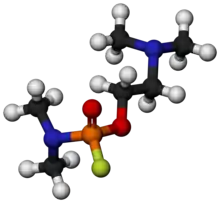 | |
 | |
| Names | |
|---|---|
| IUPAC name
2-(Dimethylamino)ethyl N,N-dimethylphosphoramidofluoridate | |
| Other names
EA-5365 | |
| Identifiers | |
3D model (JSmol) |
|
| ChemSpider | |
PubChem CID |
|
CompTox Dashboard (EPA) |
|
| |
| |
| Properties | |
| C6H16FN2O2P | |
| Molar mass | 198.176 g/mol |
Except where otherwise noted, data are given for materials in their standard state (at 25 °C [77 °F], 100 kPa).
Infobox references | |
GV (IUPAC name: 2-(Dimethylamino)ethyl N,N-dimethylphosphoramidofluoridate) is an organophosphate nerve agent. GV is a part of a new series of nerve agents with properties similar to both the "G-series" and "V-series". It is a potent acetylcholinesterase inhibitor with properties similar to other nerve agents, being a highly poisonous vapour. Treatment for poisoning with GV involves drugs such as atropine, benactyzine, obidoxime, and HI-6.[1][2]
See also
References
- ↑ Fusek J, Bajgar J (1994). "Treatment of intoxication with GV compound in laboratory rats". Sb Ved Pr Lek Fak Karlovy Univerzity Hradci Kralove. 37 (2): 57–62. PMID 7784799.
- ↑ Kassa J, Bajgar J (1996). "Therapeutic efficacy of obidoxime or HI-6 with atropine against intoxication with some nerve agents in mice". Acta Medica (Hradec Kralove). 39 (1): 27–30. PMID 9106387.
External links
Wikimedia Commons has media related to GV nerve agent.
- Harvey SP, Cheng TC (2002). "Identification, Purification, and Partial Characterization of the GV-Degrading Enzyme from ATCC # 29660 Alteromonas undina". Aberdeen Proving Ground: Edgewood. OCLC 74239874. Report ECBC-TR-229. Archived from the original (pdf) on 2013-09-09. Retrieved 2013-09-09.
- Bajgar J (1998). "Some Toxic Chemicals as Potential Chemical Warfare Agents - The Threat for the Future?". ASA Newsletter. 1998 (6).
This article is issued from Wikipedia. The text is licensed under Creative Commons - Attribution - Sharealike. Additional terms may apply for the media files.